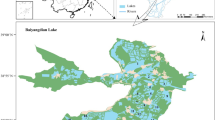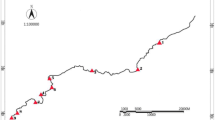Abstract
We investigated changes in aquatic macrophyte communities over 25 years in Utonai-ko (42°42′N, 141°42′E) in northern Japan and determined the major change-producing factors using canonical correspondence analysis (CCA) of 21 measured hydrochemical variables with potential to influence the occurrence of communities. We then examined the corresponding changes in the 25-year fluctuation trends in the communities and measured variables. The most prominent changes were a decline in the Hippuris community and an increase in the Vallisneria and Myriophyllum communities. CCA revealed that the leading variable was significant wave height (SWH), followed by water depth (WD), total nitrogen (T-N), dissolved oxygen (DO), pH, chlorine ion (Cl−), transparency, mud thickness, and suspended solids (SS). The Hippuris community was positively correlated with T-N and Cl− and negatively with SWH, WD, DO, and pH. All of these variables were likewise correlated with the Vallisneria and Myriophyllum communities but in the reverse direction. SS and transparency exhibited no correlations. During the 25 years, WD and T-N increased, but annual maximum wind velocity and Cl− decreased. Fluctuation of DO was <2 mg ml−1 and pH was consistent. Considering the direction of correlations and 25-year trends, vital factors for the change in aquatic macrophyte communities were WD and Cl−. Because the concentration of C1− was low, the change in aquatic macrophyte communities likely resulted from the increase in WD.







Similar content being viewed by others
References
Abernethy VJ, Sabbatini MR, Murphy KJ (1996) Response of Elodea canadensis Michx. and Myriophyllum spicatum L. to shade, cutting and competition in experimental culture. Hydrobiologia 340:219–224
Ali MM, Soltan MA (2006) Expansion of Myriophyllum spicatum (Eurasian water milfoil) into Lake Nasser, Egypt: invasive capacity and habitat stability. Aquat Bot 84:239–244
Amano K, Ooishi T (2009) Evaluation of the potential habitat distribution of submerged macrophytes in Lake Kasumigaura based on the habitat suitability analysis in the past (in Japanese). Annu J Hydraul Eng 53:1369–1374
Blindow I (1992) Long- and short-term dynamics of submerged macrophytes in two shallow eutrophic lakes. Freshw Biol 28:15–27
Chambers PA (1987) Nearshore occurrence of submersed aquatic macrophytes in relation to wave action. Can J Fish Aquat Sci 44:1666–1669
Chase JM, Knight TM (2006) Effects of eutrophication and snails on Eurasian watermilfoil (Myriophyllum spicatum) invasion. Biol Invasions 8:1643–1649
Dodson SI, Arnott SE, Cottingham KL (2000) The relationship in lake communities between primary productivity and species richness. Ecology 81:2662–2679
Donk EV, Otte A (1996) Effects of grazing by fish and waterfowl on the biomass and species composition of submerged macrophytes. Hydrobiologia 340:285–290
Durarte CM, Kalff J (1986) Littoral slope as a predictor of the maximum biomass of submerged macrophyte communities. Limnol Oceanogr 31:1072–1080
Ellawala C, Asaeda T, Kawamura K (2013) Water movement induced variations in growth regulation and metabolism of freshwater macrophyte Vallisneria spiralis L. in early growth stages. Hydrobiologia 709:173–182
Feldmann T, Noges P (2007) Factors controlling macrophyte distribution in large shallow Lake Võrtsjärv. Aquat Bot 87:15–21
Geographical Survey Institute (2003) GSI technical documentation. D1-No. 419. http://www1.gsi.go.jp/geowww/lake/chousahoukokusho.html. Accessed 1 Sep 2015
Greulich S, Bornette G (1999) Competitive abilities and related strategies in four aquatic plant species from an intermediately disturbed habitat. Freshw Biol 41:495–506
Haga H, Ohtsuka T, Matsuda M, Ashiya M (2006) Spatial distributions of biomass and species composition in submerged macrophytes in the southern basin of Lake Biwa (Japan) in summer of 2002. Jpn J Limnol 67:69–79
Hanashiro K, Omija T, Higa E, Mitsumoto H, Futenma T, Furugen K, Shimoji Y, Tashiro Y (1994) Study of muddy water resulting from soil run off (in Japanese). Annu Rep Okinawa Prefect Inst Health Environ 28:67–71
Hasegawa Y, Yoshizawa K (2013) The hydrophytes in the Cove of Lake Yamanaka (2013 year summer) (in Japanese). Annu Rep Yamanashi Inst Public Health 57:67–68
Hasegawa T, Hanaoka M, Furukawa R, Shigeno K, Nanayama F, Nakagawa M, Ando H (2013) Recognition and its significance of Tarumai-d tephra in Kushiro region, eastern Hokkaido, Japan (in Japanese). J Geol Soc Japan 119:446–456
Havens KE (2003) Submerged aquatic vegetation correlations with depth and light attenuating materials in a shallow subtropical lake. Hydrobiologia 493:173–186
Havens KE, Sharfstein B, Brady MA, East TL, Harwell MC, Maki RP, Rodusky AJ (2004) Recovery of submerged plants from high water stress in a large subtropical lake in Florida, USA. Aquat Bot 78:67–82
Hill MO (1979) TWINSPAN-a FORTRAN program for arranging multivariable data in an ordered two-way table by classification of the individual and attributes. Ecology and systematics. Cornell University, Ithaca
Hokkaido Government (1984–2010) Measurement results of public waters. http://www.pref.hokkaido.lg.jp/ks/ksk/khz/contents/mizukankyo/down/down.htm#koukyou. Accessed 1 Sept 2015
Hokkaido Government (1989–2011) Scientific reports of the Hokkaido Salmon and freshwater fisheries research institute (in Japanese). Hokkaido Government, Eniwa
Hokkaido Government (2004) Vegetation survey report pertaining to environmental improvement project of Bibi River (in Japanese). Hokkaido Government, Muroran
Hokkaido Government (2007) Nature restoration of Bibi River Plan document (in Japanese). Hokkaido Government, Hokkaido
Hokkaido Government (2010) Environmental research and analysis pertaining environmental improvement project of Bibi River (in Japanese). Hokkaido Government, Muroran
Hokkaido Government (2011) Research report of analytical study of sediment in the lake pertain to improvement work of Yufutsu River (in Japanese). Hokkaido Government, Muroran
Ikeda K, Hasaka T, Murase T (1995) Holocene sediments and topography of the Yufutsu plain in Hokkaido (in Japanese). Bull Geol Surv Jpn 46:283–300
Ito T, Mizoguti M (1995) An estimation technique of water pollution with transparency ratio (in Japanese). Bull Fac Bioresour Mie Univ 14:123–129
Japanese Industrial Standards Committee (2008) Testing methods for industrial wastewater (JIS K 0102). Japanese Industrial Standards Committee, Tokyo
Jensen KS, Riis T, Vestergaard O, Larsen S (2000) Macrophyte decline in Danish lakes and streams over the past 100 years. J Ecol 88:1030–1040
Jupp BP, Spence DHN (1977) Limitation of macrophytes in a eutrophic lake, Loch Leven: II. Wave action, sediments and waterfowl grazing. J Ecol 65:431–446
Kadono Y (1982) Occurrence of aquatic macrophytes in relation to pH, alkalinity, Ca(++), Cl(−) and conductivity. Jpn J Ecol 32:39–44
Katagiri K, Yabe K, Nakamura F, Sakurai Y (2010) Factors controlling the distribution of aquatic macrophyte communities with special reference to the rapid expansion of a semi-emergent Phalaris arundinacea L. in Bibi River, Hokkaido, northern Japan. Limnology 12:175–185
Kautsky L (1988) Life strategies of aquatic soft bottom macrophytes. Oikos 53:126–135
Kowalewski GA, Kornijów RK, McGowan S, Woszczyk M, Suchora M, Bałaga K, Kaczorowska A, Gąsiorowski M, Szeroczyńska K, Wasiłowska Agnieszka (2013) Persistence of protected, vulnerable macrophyte species in a small, shallow eutrophic lake (eastern Poland) over the past two centuries: implications for lake management and conservation. Aquat Bot 106:1–13
Kunii H (1991) Aquatic macrophyte composition in relation to environmental factors of irrigation ponds around Lake Shinji, Shimane. Jpn Veg 97:137–148
Maltchik L, Rolon AS, Schott P (2007) Effects of hydrological variation on the aquatic plant community in a floodplain palustrine wetland of southern Brazil. Limnology 8:23–28
Ministry of the Environment, Japan (2015) RAMSAR SITES in JAPAN. Ministry of the Environment, Japan, Tokyo
Mjelde M, Hellsten S, Ecke F (2013) A water level drawdown index for aquatic macrophytes in Nordic lakes. Hydrobiologia 704:141–151
Moore M, Romano SP, Cook T (2010) Synthesis of upper Mississippi River system submersed and emergent aquatic vegetation: past, present, and future. Hydrobiologia 640:103–114
Murphy KJ, Rørslett B, Springuel I (1990) Strategy analysis of submerged lake macrophyte communities: an international example. Aquat Bot 36:303–323
Nagasaka M, Yoshizawa K, Ariizumi K, Hirabayashi K (2002) Temporal changes and vertical distribution of macrophytes in Lake Kawaguchi. Limnology 3:107–114
Nakai (1987) 3 Plants. In: The natural environmental research report of Utonai-ko (in Japanese). Tomakomai, p 32–83
Nakai S, Inoue Y, Hosomi M, Murakami A (1998) A Concurrently and allelopathic effects of allelochemicals secreted by Myriophyllum spicatum on growth of blue-green algae (in Japanese). J Jpn Soc Water Environ 21(10):663–669
Nakamura S (2015) Geese of Utonai-ko. Wild Bird Rep Hokkaido 181:5–7
Nishihiro J (2011) Effect of lake water-level control on lakeshore plant regeneration (in Japanese). Jpn J Conserv Ecol 16:139–148
Nishihiro J, Kato Y, Yoshida T, Wshitani I (2014) Heterogeneous distribution of floating-leaved plant, Trapa japonica, in Lake Mikata, Japan, is determined by limitations on seed dispersal and harmful salinity. Ecol Res 29:981–989
Partanen S, Luoto M, Hellsten S (2009) Habitat level determinants of emergent macrophyte occurrence, extension and change in two large boreal lakes in Finland. Aquat Bot 90:261–268
Peck JE (2010) Multivariate analysis for community ecologists: step-by-step using PC-ORD. MjM Software Design, Gleneden Beach
Pedersen AB, Riis T (1999) Macrophyte diversity and composition in relation to substratum characteristics in regulated and unregulated Danish streams. Freshw Biol 42:375–385
Sakurai Y, Kasumigaura River Office (2004) Aquatic macrophytes of Lake Kasumigaura 1972–1993 (in Japanese). Shinzansha Publisher Co. Ltd, Tokyo
Sharip ZS, Schooler SS, Hipsey MR, Hobbs RJ (2012) Eutrophication, agriculture and water level control shift aquatic plant communities from floating-leaved to submerged macrophytes in Lake Chini, Malaysia. Biol Invasions 14:1029–1044
Takamura N, Kadono Y, Fukushima M, Nakagawa M, Kim BHO (2003) Effects of aquatic macrophytes on water quality and phytoplankton communities in shallow lakes. Ecol Res 18:381–395
Ter Braak CJF (1986) Canonical correspondence analysis: a new eigenvector technique for multivariate direct gradient analysis. Ecology 67:1167–1179
Tomakomai Weather Station (2010) Past rainfall, temperature, wind direction, wind speed and precipitation data at Tomakomai Weather Station. http://www.data.jma.go.jp/obd/stats/etrn/index.php. Accessed 1 Sept 2015
Willby NJ, Abernethy VJ, Demars BOL (2000) Attribute-based classification of European hydrophytes and its relationship to habitat utilization. Freshw Biol 43:43–74
Wison BW (1965) Numerical prediction of ocean waves in the North Atlantic for December, 1959. Deut Hydrogr Zeit 18:114–130
Yamada S, Katsui Y, Kondo Y (1963) Distribution and chronology of the Quaternary pyroclastic deposits in Hokkaido (in Japanese). Quat Res 3:80–87
Yu YT, Lur HS, Chang WL (2013) Association of water depth and aquatic-plant competition in conservation of Isoetes taiwanensis in the Menghuan Pond wetland in Taiwan. Paddy Water Environ 11:513–519
Zar JH (1999) Biostatistical analysis, 4th edn. Prentice-Hall, Upper Saddle River
Acknowledgments
We would like to thank Mr. N. Matusmoto for his technical advice in the interpretation of water chemistry data, and Editage (http://www.editage.jp) for English-language editing. We are also grateful to the Hokkaido Government Iburi General Subprefectural Bureau for providing data on water levels at Utonai-ko. This study was partly supported by funds provided as grants in aid for scientific research (Number 21510242) from the Ministry of Education, Science and Culture, Japan.
Author information
Authors and Affiliations
Corresponding author
Additional information
Handling Editor: Munemitsu Akasaka.
Rights and permissions
About this article
Cite this article
Sakurai, Y., Yabe, K. & Katagiri, K. Factors controlling changes in the aquatic macrophyte communities from 1984 to 2009 in a pond in the cool-temperate zone of Japan. Limnology 18, 153–166 (2017). https://doi.org/10.1007/s10201-016-0498-3
Received:
Accepted:
Published:
Issue Date:
DOI: https://doi.org/10.1007/s10201-016-0498-3




